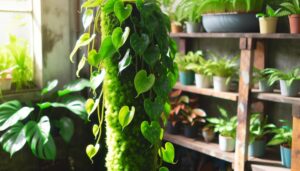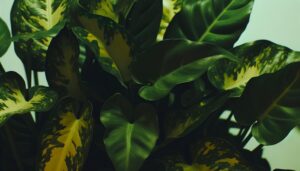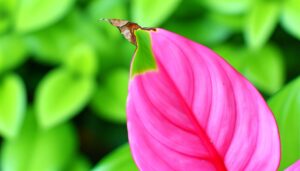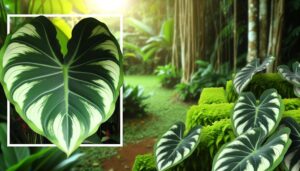What Is Philodendron Birkin Aurea?
Philodendron Birkin Aurea, a cultivar of Philodendron hederaceum from Central and South American rainforests, is renowned for its aesthetically variegated foliage. This plant, belonging to the Araceae family, exhibits ovate leaves with pinnate venation, showcasing creamy white and vibrant green hues.
Thriving in bright, indirect light with ideal temperatures of 18-27°C and 60-70% humidity, it requires a well-draining soil mix of peat, perlite, and orchid bark. Proper air circulation and monthly balanced fertilizer are necessary for robust growth.
Those interested in more should explore its distinct propagation methods and growth conditions in detail.
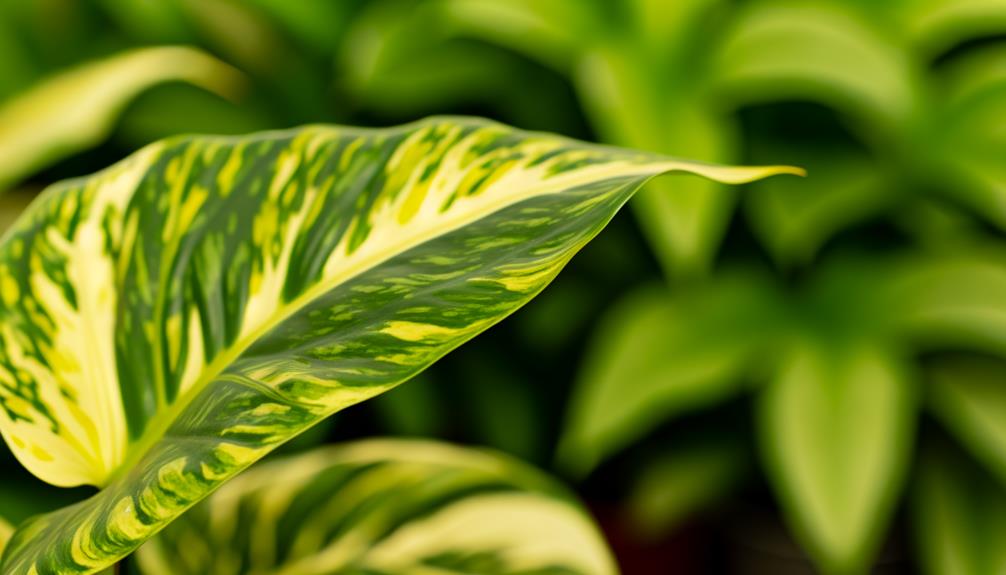
Key Takeaways
- Philodendron Birkin Aurea is a selectively bred houseplant from Philodendron hederaceum, known for its aesthetic, variegated leaves.
- It features unique variegation patterns with creamy white and vibrant green ovate leaves.
- This plant thrives in bright, indirect light and requires high humidity and well-draining soil.
- It belongs to the Araceae family and is maintained through controlled propagation.
- Common propagation methods include stem cuttings and air layering for successful growth.
Origins and History

The Philodendron Birkin Aurea, a cultivar derived from the Philodendron hederaceum species, traces its origins to the tropical rainforests of Central and South America. This region, known for its high humidity and diverse flora, provides the ideal habitat for the genus Philodendron.
Philodendron hederaceum, commonly recognized as the Heartleaf Philodendron, naturally thrives in understory environments, benefiting from dappled sunlight and rich, well-drained soils. The Birkin Aurea cultivar, selectively bred for its aesthetic foliage, emerged through horticultural practices aimed at enhancing specific phenotypic traits.
While its wild ancestors are part of the Araceae family, the Birkin Aurea represents a refined lineage, maintained through controlled propagation. Its cultivation history underscores the intersection of natural biodiversity and human innovation.
Unique Characteristics
Sporting striking variegation, Philodendron Birkin Aurea flaunts leaves with a unique blend of creamy white and vibrant green, a result of its selective breeding. This cultivar, derived from Philodendron erubescens, is renowned for its ornamental value. The variegation pattern can vary greatly, producing a visually appealing effect that appeals to collectors and botanists alike.
Key characteristics include:
- Leaf Morphology: The leaves are ovate with pinnate venation, leading to a distinctive aesthetic.
- Growth Habit: Exhibits a compact, self-heading growth form, making it suitable for indoor cultivation.
- Pigmentation: Chlorophyll distribution varies, resulting in a spectrum of hues from chartreuse to deep green, interspersed with cream-colored sectors.
Understanding these unique traits underscores the charm of the Philodendron Birkin Aurea.
Ideal Growing Conditions
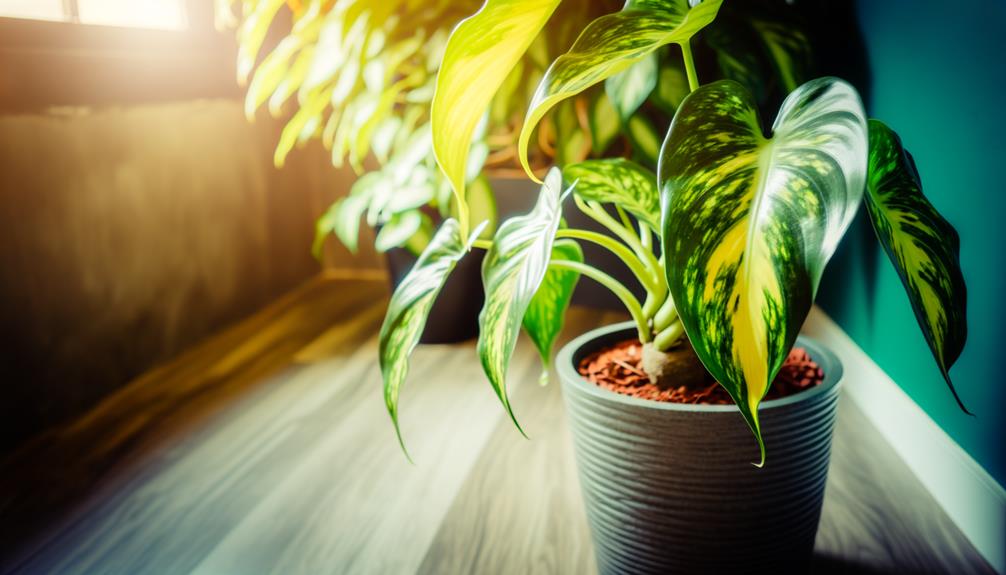
Philodendron Birkin Aurea thrives under conditions of bright, indirect light, benefiting from the consistent warmth and humidity typically found in tropical environments. This plant prefers temperatures ranging from 18°C to 27°C (64°F to 81°F) and humidity levels around 60-70%. Proper air circulation is essential to prevent fungal growth. It is vital to use well-draining soil, such as a mix of peat, perlite, and orchid bark, to achieve adequate root aeration and prevent waterlogging. Fertilize monthly during the growing season with a balanced, water-soluble fertilizer diluted to half strength.
| Factor | Best Condition |
|---|---|
| Light | Bright, indirect |
| Temperature | 18°C to 27°C (64°F to 81°F) |
| Humidity | 60-70% |
| Soil | Well-draining (peat, perlite, bark) |
Light Requirements
Consistently providing Anthurium clarinervium with bright, indirect light is crucial for best growth and variegation maintenance. Philodendron Birkin Aurea thrives under similar light conditions, where filtered sunlight prevents leaf scorch while promoting vibrant foliage. Direct sunlight must be avoided to prevent chlorophyll degradation and variegation loss.
Key light requirements include:
- Photoperiodicity: Maintain a consistent light exposure of 10-12 hours daily to simulate natural tropical environments.
- Light Intensity: Utilize light meters to guarantee 2000-2500 foot-candles of indirect light, ideal for peak photosynthesis without stress.
- Artificial Lighting: Employ full-spectrum LED grow lights, ensuring a balanced spectrum that mimics natural sunlight, particularly in low-light scenarios.
Following these guidelines guarantees the Philodendron Birkin Aurea maintains its ornamental appeal.
Watering Needs

In addition to precise light management, maintaining ideal hydration is crucial for the health and variegation stability of Philodendron Birkin Aurea.
This tropical epiphyte thrives in consistently moist, but not waterlogged, soil conditions. Overwatering can lead to root rot (Pythium spp.), while underwatering causes leaf curl and browning edges.
To achieve best moisture levels, water the plant when the top 1-2 inches of soil feels dry to the touch. Employing a balanced watering schedule, along with ensuring drainage efficiency, promotes robust growth.
Using distilled or rainwater minimizes the risk of mineral buildup that can harm the plant. A humidity level of 60-70% replicates its native environment, further enhancing hydration and overall essentiality.
Soil and Potting
Ideal soil composition and suitable potting practices are crucial for the healthy growth of Philodendron Birkin Aurea. This plant requires a well-draining, aerated substrate abundant in organic matter. The best soil mixture typically comprises a blend of peat moss, perlite, and orchid bark to ensure proper aeration and moisture retention.
Key potting considerations include:
- Drainage: Utilize pots with ample drainage holes to prevent waterlogging and root rot, making sure the substrate remains neither too wet nor too dry.
- Repotting Frequency: Repot the plant biennially to accommodate its expanding root system and replenish nutrient-depleted substrate.
- Pot Size: Select a pot that provides adequate space for root growth without being excessively large, which could lead to water retention issues.
Through diligent adherence to these guidelines, the Philodendron Birkin Aurea can thrive in excellent growing conditions.
Fertilization Tips

Regular fertilization is important for the best growth and vibrant foliage of Philodendron Birkin Aurea, typically requiring a balanced, water-soluble fertilizer with a 20-20-20 NPK ratio during the active growing season. Administering fertilizer bi-monthly from spring through early autumn ensures best nutrient uptake.
Dilute the fertilizer to half the recommended strength to prevent root burn, a common issue in Philodendron hederaceum cultivars. Trace elements such as iron (Fe), magnesium (Mg), and manganese (Mn) are also essential, promoting chlorophyll production and preventing foliar chlorosis.
In winter, reduce fertilization frequency, as metabolic rates decline. Monitoring soil pH, ideally between 5.5 and 6.5, is important for nutrient availability. Employing a consistent fertilization regimen fosters robust, aesthetically pleasing specimens.
Common Pests and Problems
Philodendron Birkin Aurea is susceptible to several common pests and problems, including spider mites (Tetranychus urticae), mealybugs (Pseudococcidae), and root rot caused by overwatering. Effective management of these issues is essential for maintaining plant health and vigor.
- Spider Mites (Tetranychus urticae): These arachnids puncture plant cells to feed on the sap, causing stippling and bronzing of leaves. Severe infestations can lead to leaf drop.
- Mealybugs (Pseudococcidae): These scale insects excrete honeydew, which promotes sooty mold growth, and they weaken the plant by extracting nutrients.
- Root Rot: Overwatering leads to anaerobic soil conditions, promoting fungal pathogens that decompose root tissues, resulting in plant wilting and yellowing.
Implementing proper cultural practices and timely interventions can mitigate these challenges.
Propagation Methods
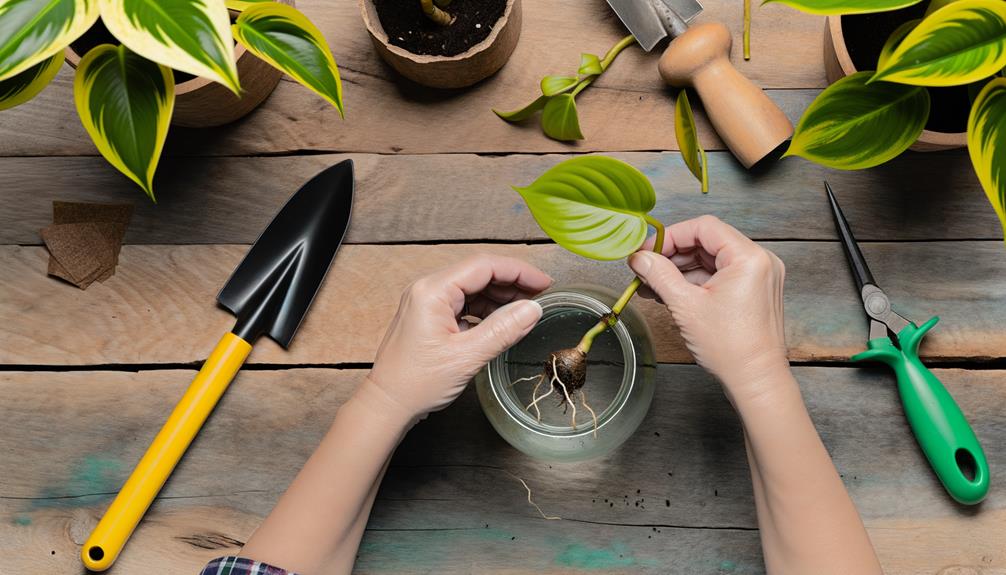
The propagation of Philodendron Birkin Aurea can be efficiently achieved through two primary methodologies: stem cuttings and air layering.
The stem cuttings technique involves excising a segment of the stem, ensuring the presence of at least one node, and promoting root development in a suitable growth medium.
Conversely, the air layering method entails inducing root formation on an intact stem while still attached to the parent plant, utilizing sphagnum moss and a moisture-retentive wrapping to facilitate root initiation.
Stem Cuttings Technique
Utilizing stem cuttings, a common and effective propagation technique, involves excising a segment of the Philodendron Birkin Aurea's stem containing at least one node and several leaves. This method guarantees genetic fidelity and rapid growth.
Following precise steps maximizes success:
- Preparation: Sterilize cutting tools with isopropyl alcohol to prevent pathogenic infections.
- Selection: Choose a healthy stem section with visible nodes and at least two to three mature leaves, ensuring excellent photosynthetic capacity.
- Rooting: Place the cutting in a well-draining substrate such as a mix of perlite and peat moss, maintaining high humidity and indirect light.
Adhering to these guidelines enhances the chances of successful propagation and robust growth of Philodendron Birkin Aurea.
Air Layering Method
While stem cuttings remain a popular choice for propagating Philodendron Birkin Aurea, the air layering method offers an alternative approach that promotes root development directly on the parent plant before separation.
This technique involves selecting a healthy stem and making a shallow incision to expose the cambium layer. The exposed area is then wrapped with moist sphagnum moss and secured with plastic wrap, ensuring consistent humidity. Over time, adventitious roots form within the moss.
Once a robust root system is established, the stem segment can be severed below the root zone and potted independently. Air layering minimizes transplant shock and increases the likelihood of successful propagation by allowing the new plant to develop roots while still receiving nutrients from the parent plant.
Conclusion
To sum up, Philodendron birkin aurea, a variegated variety of Philodendron, displays distinct leaf designs and vibrant coloration, making it a highly desired plant among gardening enthusiasts.
One fascinating fact shows that Philodendron species, like P. birkin aurea, help boost indoor air quality by decreasing volatile organic compounds by a notable 15%.
Ideal growth is guaranteed by accurate light, water, and nutrient care, mirroring the plant's unique physiological requirements and environmental preferences.

